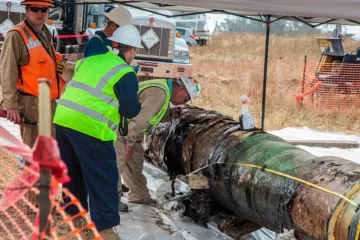
By Katie Davis

Plains pipeline from the 2015 Refugio Beach disaster.
(Photo by Bruce Reitherman, Santa Barbara County)
Analysts who have taken a close look at Sable -- an oil startup hoping to restart Exxon’s shuttered offshore oil production in the Santa Barbara Channel -- are calling it a “pipe dream.”
For instance, an extensive article (https://hntrbrk.com/sable/) by Hunterbrook Media details many of the obstacles Sable faces and starts with this summary:
“Sable Offshore (NYSE: $SOC) is racing against the clock to relaunch an idle fossil fuel complex it bought from Exxon (NYSE: $XOM) in February. Three oil and natural gas platforms, called the Santa Ynez Unit, have not produced fossil fuels since one of the pipelines carrying its oil ruptured in 2015. It was the biggest spill in California since 1990. After seven years, Exxon gave up trying to overcome the legal hurdles required to get Santa Ynez and the pipeline back online. Now, despite facing similar obstacles, Sable is telling shareholders it can restart production before October. Since Hunterbrook Media began reporting, Sable withdrew and refiled a key plan, likely increasing the risk of delays.
Hunterbrook Media’s Editorial Board believes that Sable Offshore will not restart production at Santa Ynez on time, if at all. Sable listed on NYSE via SPAC as $SOC earlier this year. The company’s auditors have since flagged Sable’s ability to continue as a “going concern.” Our Editorial Board agrees.
Exxon — a more well-capitalized and experienced company — spent seven years trying (and failing) to bring Santa Ynez back online. Sable’s only apparent novel approach seems to be an attempt to bypass Santa Barbara County, which will likely only bring more scrutiny in California, a state not known as fossil fuel friendly.
The CEO’s most recent prior company, Sable Permian Resources, went bankrupt. Before that, he flamed out from Freeport-McMoRan. Now, he and his repeat management team seem to be relying on a highly speculative gamble at the mercy of California regulators, litigators, and communities.”
Since this article was published in April, Sable has faced additional challenges. Their application to the Fire Marshal to bypass Santa Barbara County was denied. Their applications to change ownership from Exxon to themselves were deemed incomplete by both the County and the State Lands Commission so will not be considered anytime soon.
And the settlement they made with landowners who refused access to the pipeline may not be as settled as they claim. We have learned that some landowners are opting out of the settlement.
Sable is financed by a loan from Exxon and speculative funding through a blank check company with the goal to take over and restart three offshore oil platforms, the gas and oil pipelines, including the one that burst and caused the 2015 Refugio oil spill, and the Santa Ynez oil processing facility on the Gaviota coast, which when operating was the largest facility source of greenhouse gas and health-damaging air pollution in the County.
However, decision makers will be highly skeptical of Exxon offloading liability for its aging oil operation to a startup company that would disappear in the event of a spill or other disaster.
Climate on the Ballot
Good news on the ballot front. The oil industry has given up efforts to overturn a law limiting drilling dangerously close to homes that they had qualified for the November general election.
In 2022 California banned oil drilling next to homes, schools and businesses in recognition that everyone deserves clean air and healthy neighborhoods. Living near oil and gas production is linked to a higher risk of asthma, birth defects and cancer. The oil industry could see that they were not going to persuade voters to eliminate these health and safety buffers and withdrew their ballot measure.
Instead, Californians will get a chance to vote on climate funding. In July the legislature passed The Safe Drinking Water, Wildfire Prevention, Drought Preparedness, and Clean Air Bond Act of 2024.
This authorizes a first-of-its-kind $10 billion general obligation bond to finance projects for safe drinking water, drought, flood, and water resilience, wildfire and forest resilience, coastal resilience, extreme heat mitigation, biodiversity and nature-based climate solutions, climate-smart, sustainable, and resilient farms, ranches, and working lands, park creation and outdoor access, and clean air programs. Each of these bonds are now eligible to appear on the November 8, 2024 General Election ballot.